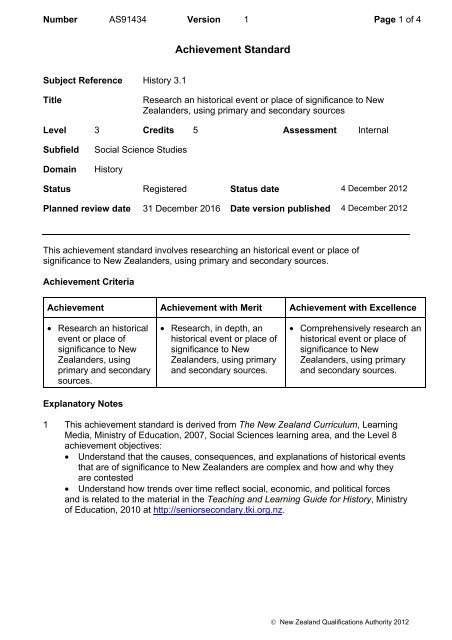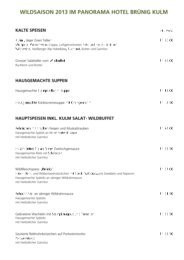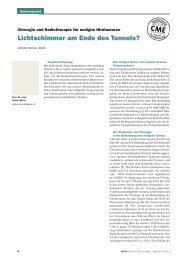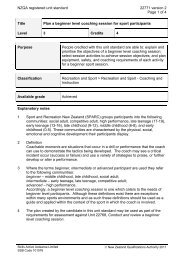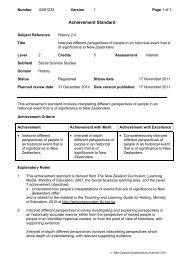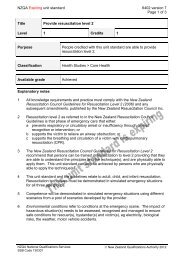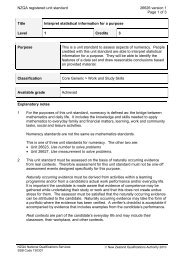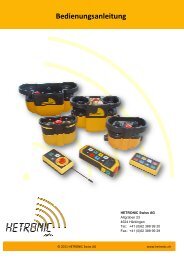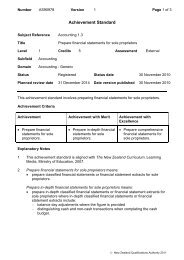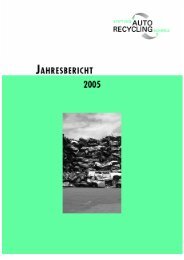76KB - NZQA
76KB - NZQA
76KB - NZQA
You also want an ePaper? Increase the reach of your titles
YUMPU automatically turns print PDFs into web optimized ePapers that Google loves.
Number AS91434 Version 1 Page 1 of 4<br />
Achievement Standard<br />
Subject Reference History 3.1<br />
Title<br />
Research an historical event or place of significance to New<br />
Zealanders, using primary and secondary sources<br />
Level 3 Credits 5 Assessment Internal<br />
Subfield<br />
Domain<br />
Social Science Studies<br />
History<br />
Status Registered Status date 4 December 2012<br />
Planned review date 31 December 2016 Date version published 4 December 2012<br />
This achievement standard involves researching an historical event or place of<br />
significance to New Zealanders, using primary and secondary sources.<br />
Achievement Criteria<br />
Achievement Achievement with Merit Achievement with Excellence<br />
• Research an historical<br />
event or place of<br />
significance to New<br />
Zealanders, using<br />
primary and secondary<br />
sources.<br />
Explanatory Notes<br />
• Research, in depth, an<br />
historical event or place of<br />
significance to New<br />
Zealanders, using primary<br />
and secondary sources.<br />
• Comprehensively research an<br />
historical event or place of<br />
significance to New<br />
Zealanders, using primary<br />
and secondary sources.<br />
1 This achievement standard is derived from The New Zealand Curriculum, Learning<br />
Media, Ministry of Education, 2007, Social Sciences learning area, and the Level 8<br />
achievement objectives:<br />
• Understand that the causes, consequences, and explanations of historical events<br />
that are of significance to New Zealanders are complex and how and why they<br />
are contested<br />
• Understand how trends over time reflect social, economic, and political forces<br />
and is related to the material in the Teaching and Learning Guide for History, Ministry<br />
of Education, 2010 at http://seniorsecondary.tki.org.nz.<br />
© New Zealand Qualifications Authority 2012
Number AS91434 Version 1 Page 2 of 4<br />
2 Research using primary and secondary sources involves:<br />
• following a research process<br />
• evaluating the research process, for example explaining the successes and<br />
difficulties encountered in conducting the research, explaining how the line of<br />
inquiry may have changed as evidence was accumulated, identifying the issues to<br />
consider for future inquiries.<br />
Research, in depth, using primary and secondary sources involves:<br />
• making annotations that include assessment of the reliability of selected evidence.<br />
Comprehensively research, using primary and secondary sources involves:<br />
• showing initiative in the gathering and selecting of relevant evidence, which may<br />
include persevering with difficult sources, and/or using evidence from sources<br />
which are not readily available<br />
• evaluating the research process, for example by analysing the strength(s) and<br />
weakness(es) of the process, analysing how these strength(s) and weakness(es)<br />
are likely to impact on the validity of the findings, considering alternative research<br />
steps and/or line(s) of inquiry and/or methods, and their implications.<br />
3 Following a research process typically involves:<br />
• preparing a research proposal that explains the importance of the topic proposed<br />
• developing focusing question(s) that result from preliminary research<br />
• identifying specific possible sources through preliminary readings<br />
• selecting sufficient relevant historical evidence from both primary and secondary<br />
sources to enable comprehensive analysis of an historical place or event<br />
• making annotations that identify the relevance, and assess the comparative<br />
usefulness, of the selected evidence in terms of the focusing question(s) being<br />
investigated<br />
• organising this evidence<br />
• recording the details of the sources of selected evidence.<br />
4 Sources are places where evidence may be found. Sources may include people,<br />
books, libraries, museums, newspapers, artefacts, historical sites, videos, websites,<br />
graphs, cartoons, films, recorded radio programmes, DVDs, blogs, archives,<br />
memorials, graveyards, collections of letters, diaries, and theses.<br />
5 Evidence from primary sources may be drawn from one or more primary sources,<br />
such as interviews and transcripts; letters; diaries; government papers; wills;<br />
newspaper clippings; photographic files; birth, death and marriage records; statistics;<br />
and census data.<br />
6 Sufficient source details are recorded to allow the later creation of a reference<br />
list/bibliography. Normally, required details include author, title, publisher, city of<br />
publication, date of publication, full URL and accession date(s). A full reference<br />
list/bibliography is not required for this achievement standard.<br />
© New Zealand Qualifications Authority 2012
Number AS91434 Version 1 Page 3 of 4<br />
7 An historical event is understood to be:<br />
• a specific historical event, eg Hyde Rail Disaster, Kaitangata Mine Disaster,<br />
Napier Earthquake, Ballantyne’s Fire<br />
• an historical development or movement, eg Ratana, suffragettes, civil rights<br />
movements<br />
• a person’s role in and contribution to a significant historical event or movement,<br />
eg Kate Sheppard and Women’s Suffrage, Nelson Mandela and civil rights in<br />
South Africa, Morrie Davis and the Mt Erebus Disaster.<br />
8 An historical place is understood to be:<br />
• a place where something significant in history has happened, eg Parihaka<br />
• a place where something significant is commemorated, eg a local war memorial,<br />
the tomb of the unknown soldier<br />
• a place where something significant is contained, eg cemetery, museum, marae.<br />
9 Significance may be determined by:<br />
• the importance of the event, or place, to people alive at the time<br />
• how deeply people’s lives were affected at the time<br />
• how many lives were affected<br />
• the length of time people’s lives were affected<br />
• the extent to which the event, or place, continues to affect people.<br />
10 An event of significance to New Zealanders is understood to be:<br />
• an historical event occurring within New Zealand<br />
• an historical international event involving New Zealanders<br />
• an historical international event influencing New Zealanders.<br />
11 Where an historical person is prominent in the investigation, it is not sufficient simply<br />
to present a biography. The focus of the investigation should be on the historical<br />
person’s role in, or contribution to, an historical event, or place, eg Ettie Rout and<br />
health issues, Martin Luther King and the civil rights movement, Osama Bin Laden<br />
and the Islamic revolution.<br />
12 To be of significance to New Zealanders, an event does not have to be located in<br />
New Zealand.<br />
13 Conditions of Assessment related to this achievement standard can be found at<br />
www.tki.org.nz/e/community/ncea/conditions-assessment.php.<br />
Replacement information<br />
This achievement standard replaced unit standard 5831 and AS90654.<br />
Quality Assurance<br />
© New Zealand Qualifications Authority 2012
Number AS91434 Version 1 Page 4 of 4<br />
1 Providers and Industry Training Organisations must have been granted consent to<br />
assess by <strong>NZQA</strong> before they can register credits from assessment against<br />
achievement standards.<br />
2 Organisations with consent to assess and Industry Training Organisations assessing<br />
against achievement standards must engage with the moderation system that applies<br />
to those achievement standards.<br />
Consent and Moderation Requirements (CMR) reference 0233<br />
© New Zealand Qualifications Authority 2012


